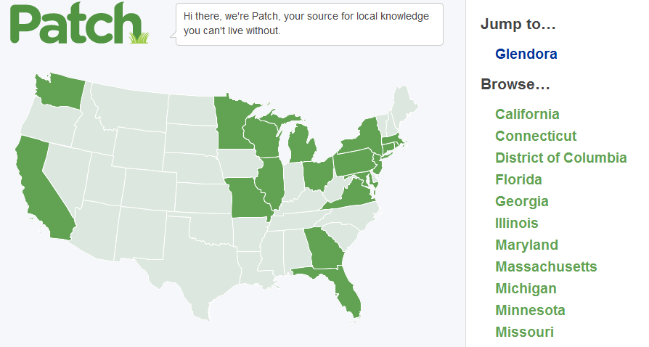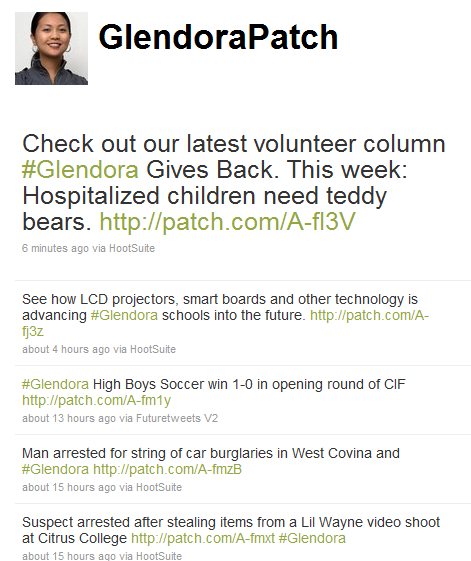BY NATASHA ZOUVES/ AAJA-LA (2010-2011 Sam Chu Lin Memorial Scholarship recipient, USC junior)
Like many Filipina aunts and cousins before her, Hazel Lodevico To’o was supposed to be a nurse. So she had to explain exactly what she was doing as she sat at her local coffee shop, quickly typing up an article to post on Patch.com.
“Patch is a lifestyle, it really is,” To’o said. “It pretty much is a 24-7 type job. You’re independent, so your office is everywhere. Your office is your home, your office is at a coffee shop.”
Hazel from Patch.com 60D from natasha zouves on Vimeo.
Since becoming the local editor for Glendora.Patch.com three months ago, one of the hundreds of new AOL journalism hires introduced to a re-cast corporate view of community news, To’o’s life has changed dramatically. AOL’s Patch initiative has received some critical attention from the media, but it’s one of the few media enterprises with ambitions of growth, allowing veteran media talent like To’o to do what they know best: report the news.
To’o’s new lifestyle is definitely not the life her mother saw for her.
“Being Filipina, my mom was disappointed that I didn’t want to be a nurse,” To’o laughed. “At one point I definitely heard encouragement from my relatives saying, ‘You know, nursing school is still accepting applicants.’ But I just knew nursing wasn’t for me and my fulfillment came out of journalism.”
To’o said she has known her calling ever since she was the editor at her high school paper.
“Those were the days of actual cut and paste, with x-acto knives,” To’o said.
Since then, things have gotten considerably higher-tech for To’o. As the local editor of Glendora.Patch.com, she is in charge of covering her community along with a staff of about 11 freelance writers. It’s a job that she took three months ago, and one that she said took a lot of getting used to.
“It started off very, very hectic, very busy,” To’o said. “This is far different from any journalism job that I’ve ever had. You’re definitely more involved in this job. It’s not like you can just leave the office and then go home.”
Patrick from Patch.com 60D from natasha zouves on Vimeo.
To’o, who has a background in community and daily newspapers including the OC Register, is clearly passionate about her new job. She described the first few weeks as filled with high work demands and little sleep.
“People wonder why do you want to do this when the hours are long, when the pay is not what everyone would desire,” To’o said.
But to understand the coffee shops, the hours, the pay and the Patch.com revolution, one first has to understand where the idea of Patch.com and the idea for “hyperlocal” journalism came from.
The Birth of Patch
The birth of Patch.com started with a realization.

Tim Armstrong, the man who would eventually become chief of AOL, realized that he couldn’t find very much information online about the community in which he lived—Riverside, Connecticut. This prompted Armstrong, along with Jon Brod, to found Patch.com in 2007.
The “hyperlocal” model was new, where a paid local editor would cover his or her own community in minute detail—from decisions in local government to restaurants opening and closing—with a staff of freelancers. Within two years, the little website would be acquired by AOL. From there, Patch.com started to grow exponentially.
When AOL bought it in 2009, Patch only had six sites. But by early December 2010, Patch.com had branches in over 500 communities across the country, including To’o’s branch in Glendora, California. This makes AOL one of the largest hirers of journalists in the U.S. And last year, AOL announced that it would be investing $50 million or more in Patch.com, perhaps hoping for a big payoff in untapped local advertising. Specifically, what AOL estimates to be $20 billion in local online advertising.
It’s just the company’s first step in what Forbes Magazine called “AOL’s Plan To Own Your Neighborhood.”

Overworked and Underpaid?
For To’o, the first few weeks of working at Patch were comprised of endless days and sleepless nights.
“I’m not going to lie, it was very difficult,” said To’o, recalling the launch of the Glendora site last December. “It was tough, it was long hours, spending most of my day, trying to figure out how to manage this new thing.”
According to Patch, editors make between $38K-$45K a year and are given a weekly freelance budget of around $500. It’s the paycheck and long hours that prompted one Patch editor to submit a widely-circulated anonymous e-mail to a Northeastern University journalism professor. In it, she described 70-hour work weeks with no vacation time.

To’o said that an 80-hour-week is not uncommon at Patch.
“Yes, it is a demanding job, and, yes, you may find yourself working very, very long hours,” To’o said. “Some journalists at Patch would say that, ‘I don’t get a day off.’ So do I feel like I’m overworked? I mean yeah, it’s very demanding. But I think back to the days when I was a beginning reporter at a small community newspaper where I was spending a lot of hours. And, yes, an 80 hour week wasn’t unusual back then either.”
Patrick Lee, the regional editor for Los Angeles, says that long hours just come with the territory. He is responsible for 11 Patch sites throughout the San Gabriel Valley and northeast Los Angeles.
“I think any journalist will tell you that they’re overworked,” Lee said. “It’s not a nine-to-five job. It’s partly because we love what we do and it’s really hard to walk away from it. And it’s partly the nature of the beast. Things happen all hours of the day and night and you need to be available to cover them and write about them.”
Patch has responded to the allegations of “sweatshop” pay by saying that they’re just plain false. Janine Iamunno, senior communications director for Patch, told Business 2 Community, a business publication, that three out of four Patch employees make more money, or the same amount, that they made in their previous positions.
Regardless of money, both To’o and Lee were quick to describe their jobs with Patch as the most fulfilling jobs they’ve had so far.
“I’ve been able to do more things in this job than I have been able to do in almost any other job,” said Lee. “I’ll just say that it’s a tough job, but it’s a great job, and I think if you ask any of the editors working for [Patch] they’ll tell you that they’ve never had a better journalism experience.”
Competition in the Local Media Market
In many ways, Glendora is a typical Patch community.
In 2006, Glendora’s population was around 51,608, right in Patch’s bracket of serving communities of 15,000 to 70,000 people. It’s also typical in that, now that Patch has come to town, Glendora is finding itself in a struggle between traditional local media and the new online model.
It’s a fight in which some perceive Patch to be the Goliath–LA Weekly called Patch “The WalMart of news.”
“We studied [the business] of daily newspapers of the towns we were going into, and found that if we stripped out costs like paper or broadcast towers, we can operate at 4.1% of cost of a daily newspaper,” said Warren Webster, the president of Patch.com, in an interview with Forbes Magazine last year.
It’s this competitive edge that Patch is banking on, and one that To’o sees as healthy.
“If we continue to let local journalism just be the way it is now, without trying to figure out something new and something to progress the state of local journalism, it would just pretty much cease to exist,” said To’o. “What we’re trying to do is help local journalism. We’re not there to kill what’s out there.”
But it’s not only friendly competition. In some circles Patch has developed a reputation for “stealing” away journalists from local papers, earning it the nickname “Poach.”
Timothy Rutt, the publisher of a Los Angeles neighborhood blog AltadenaBlog.com, wrote about how he was approached by Patch to leave the website and open up a Patch site in the same neighborhood.
Rutt wrote: “What would we be if we shut this down to create a second rate version of ourselves at the behest of a corporation that has no real interest in this community, except to extract dollars from it?…We thank Poach on one hand for basically telling us to step up our game.”
To’o insists that the so-called battle line is not usually this nasty in her town. There are two newspapers, one magazine and one blog that all cover the Glendora area, and she said that if there is any hostility, she’s not aware of it.
“Whenever we see each other at the same events or functions, it’s not like, ‘Oh, there’s that person from that place.’ Sometimes they’ll tip me off on things that they won’t cover as a weekly publication but I might since I’m daily,” said To’o.
What Patch Does (Really) Well
In an industry that many classify as flailing, Patch may be a welcome way out.
The State of the News Media reported that in 2002 there were 1,457 newspapers being published in the U.S., which is a 17% decrease from 22 years prior.
To’o explained that many of her Patch colleagues have long resumes in the journalism industry and came to Patch after being laid off.
“A lot of our colleagues come from the LA Times, from the OC Register, they’ve been journalists for decades,” To’o said.
Patch’s role may be to catch talented journalists who would otherwise fall through the cracks. LA Regional Editor Patrick Lee is one of these people. After years of working at newspapers like the LA Times, he came to Patch in 2009.
“I think we’re offering a new model for journalism that I think is very exciting for people who are mid-career and are looking for a new way to do what they do in a venue that is more creative and more open to what they have to offer,” Lee said.
Patch also allows communities to interact with its news. User-generated content, listings of weekend activities, and contact information for city officials can all be found on the local sites.
The company encourages employees to give back to the communities in which they work. Warren told Forbes Magazine that Patch donates five paid employees per year to a volunteer organization. Patch takes it so seriously that a reported 15% of a journalist’s performance evaluation is based on their volunteer work. And the community sites make it easy to find volunteering opportunities close by.
Filling a void in the journalism industry, promoting community involvement, and helping others, all good things according to To’o and Lee. And just the beginning for Patch.
It seems that before the public’s eyes, what once was a little patch is growing into a great, big, giant, Super-Bowl-sized field. What that exactly means for local journalists, community dwellers, executives, advertisers and indeed for journalism as a whole remains to be seen.
As for To’o, the stability of her Patch job has caused her relatives to finally drop the nursing campaign.
“They’ve eased off now,” said To’o with a smile, “Especially with what they’re seeing I’m doing with Patch. We’re working together as a team to create something that could be the biggest thing to happen to journalism in a long time. So they’re much more supportive now.”
FOR MORE MEMBERSHIP COVERAGE:
A CENTURY ON, RE-ENVISIONING A 21st CENTURY RAFU SHIMPO: Samantha Masunaga (Peter Immamura Memorial Scholarship recipient/ UCLA junior) talks to editors at the largest and oldest Japanese daily newspaper about grappling with a changing newspaper industry.
‘GRADING THE TEACHERS’: 100 interviews later…: Sonali Kohli (AAJA-LA scholarship winnner/ UCLA sophomore) interviews education reporter Jason Song about preparing the 2010 LA Times series on value-added analysis.
LIFEYO: Blogging made Simple(r): Steffi Lau (scholarship recipient/ USC senior) interviews Lifeyo CEO Mike Kai, 28, who founded a website hosting platform that aims to simplify the website-building experience with drag-and-drop features, allowing users to customize content and create a site within minutes.
| NATASHA ZOUVES is a junior at USC double majoring in broadcast journalism and health promotion. She is the 2010-2011 Sam Chu Lin Memorial Scholarship recipient
|


 “It is seldom that an instructor at our school has someone in class as energetic, gifted and personable as Ms Zouves.” — Larry Pryor, USC associate professor
“It is seldom that an instructor at our school has someone in class as energetic, gifted and personable as Ms Zouves.” — Larry Pryor, USC associate professor